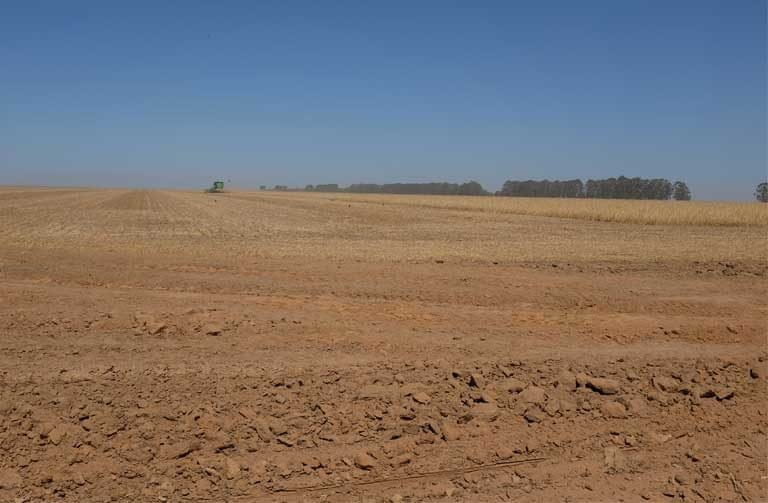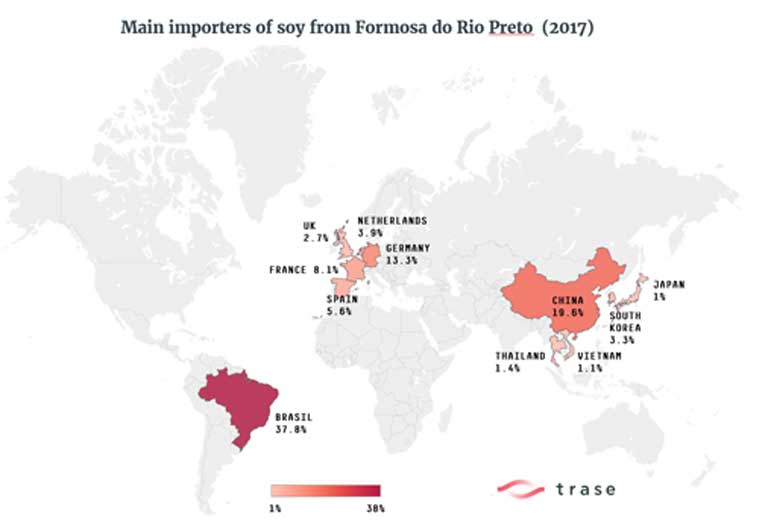- Agronegocio Condominio Cachoeira do Estrondo, known as Estrondo, is an immense mega-farm in the Brazilian Cerrado savanna in Bahia state. It covers a minimum of 200,000 hectares (494,000 acres). Much soy produced in the local region is exported to the EU and China.
- There is evidence Estrondo was born of land grabbing and fraud, accusations the mega-farm denies. It is now caught up in a major investigation by federal police on alleged corruption involving judges, lawyers and farmers, accused of conspiring to secure favorable court rulings to legitimize land grabbing.
- Estrondo’s astronomical land growth was based partly on a takeover of common lands used by seven traditional communities to raise small cattle herds, grow sustainable crops, and for hunting and gathering — land rights guaranteed under Brazilian law.
- Estrondo has installed fences, watchtowers and hired armed guards to protect its land claims. Villagers report that Estrondo’s hired security force has threatened and intimidated them, and there are documented cases of multiple ongoing conflicts including shootings.

A Mongabay team, Sarah Sax and Maurício Angelo, recently traveled to the Brazilian Cerrado to report on the impacts of booming agribusiness on the savanna environment and on the traditional people living there. This is the second story in a series telling what they found there.
ALDEIA, Formosa do Rio Preto municipality, Bahia state, Brazil — Guilherme Ferreira de Souza’s world changed forever one day in 2009. That fateful morning, he traversed the distance from his home in a lush savanna river valley, up onto the high plains mesa where his cattle grazed, only to find the shrubby dry forest razed in preparation for the planting of row crops.
That moment has since morphed into what investigators say could be one of the biggest land grabs in Bahia state history. One judge already incarcerated in the case gave a favorable decision to a mega-farm that took over lands where traditional communities had lived for generations. Other evidence indicates that this same farm may have originated through a fraudulent land deal made by one of the companies that started it — the Delfin Group, owned by Ronald Guimarães Levinsohn, a Rio de Janeiro millionaire dubbed the “conqueror of western Bahia.”
That vast mega-farm of interconnected soy, corn and cotton plantations known collectively as the Agronegocio Condominio Cachoeira do Estrondo is located in Brazil’s fourth largest soy producing municipality, Formosa do Rio Preto, which exports a large portion of its agricultural commodities to the EU and China, mainly for animal feed. Known locally as “Estrondo,” the mega-farm now has extended virtually to de Souza’s doorstep.
Guards paid for by Estrondo have erected watchtowers and fences to block villagers from accessing their traditional lands, and these armed men have reportedly repeatedly intimidated members of the seven communities that live in the valley. In addition, the 400 people who have resided here their entire lives find themselves encircled by soy and cotton fields that are heavily sprayed with toxic pesticides that run off into the Rio Preto from which local residents drink.
“About five years ago, they came down here, near us,” de Souza told Mongabay when a reporting team visited the community in 2019. “Today there are six watchtowers around us, and they are building more.”
According to Aldeia inhabitants, Estrondo has even blocked them from accessing the other six small communities located farther down the valley. “They do not let us pass,” de Souza told us, drinking sweet coffee as the sun shone hotly down on the simple structure that serves as his kitchen, living room, and the communal gathering place for the village. “We are cornered — trapped inside.”

Local people in legal battle against corruption
De Souza and his neighbors — traditional farmers and descendants of indigenous and Afro-Brazilian quilombola peoples — have fought back in court. In 2017, a lower court granted the seven local traditional communities their right to 43,000 hectares (106,000 acres) bordering the Estrondo estate and ordered the removal of Estrondo’s security cabins. The decision was upheld in May 2018 by a Bahia state court of appeals.
When asked by Mongabay why Estrondo had still not complied with the court rulings, FSB Comunicação, the public relations agency representing Estrondo, cited an excerpt from a court order written by Judge Sérgio Humberto Sampaio, a municipal judge in Formosa do Rio Preto on November 27, 2018. Sampaio issued a favorable decision to Estrondo, reducing the area claimed by the geraizeiros communities from 43,000 to 9,000 hectares (106,000 to 22,000 acres).
Sampaio is now one of several judges and rural producers targeted in a federal police investigation, dubbed “Operation Far West,” and is one of few judges to be incarcerated already. The Superior Court of Justice (STJ), who is investigating the case, recorded financial transactions of 14 million reais (US$3.3 million) linked to Sampaio between January 2013 and 2019. Of the total 7 million reais (US$1.7 million) he received, only 1.7 million reais (US$402,000) were in salary payments.

Industrial agribusiness swallows up traditional lands
Since its inception, Agronegocio Condominio Cachoeira do Estrondo has grown to be Bahia’s largest agribusiness landholding. The exact size of the mega-farm is uncertain; in a Mongabay request for comment, Esrondo claimed its agribusiness tenants occupied only 200,000 hectares (494,000 acres). However according to NGO Greenpeace, up until the recent investigation Estrondo claimed to occupy 305,000 hectares (754,000 acres) on its website — an area roughly four times the size of New York City.
The mega-farm encompasses 41 tenants who grow commodities mostly for export. While exact numbers from Estrondo are unavailable, half the soy planted in Formosa do Rio Preto, the municipality where Estrondo operates, is bought by only a handful of traders, including Bunge, Cargill and ADM, and shipped to China and the European Union.
Estrondo’s vast plantation network has been mired in controversy and conflict since its earliest days, with allegations of slave labor, illegal deforestation, land grabbing, and violence against local people. In 2019 private guards, paid by the farm, shot traditional community members attempting to graze their cattle, in what people say was an attempt to evict them from traditional pasturelands.
However, the dispute between Estrondo and Aldeia isn’t a local anomaly. The last report from the Comissão Pastoral da Terra (CPT), an organ of the Brazilian Catholic Church that deals with the problems of the rural poor, identified 1,489 land conflicts in Brazil in 2018, including complaints involving land, water, labor, drought, mining and violence against local people — conflicts marked by murders, threats, aggression and arrests. Of that total, 1,124 centered on land conflicts, with about one million people involved; that’s a 36% increase between 2017 and 2018.
Traditional populations are the target of 73.5% of conflicts over land and water. In 2018, the state of Bahia alone recorded 182 rural conflicts involving 156,000 people, says the CPT.

An island in a sea of soy
It’s no understatement to say that the village of Aldeia is an island in a sea of soy. We started our journey there from one of Bahia’s fastest growing cities, Luís Eduardo Magalhães, which two decades ago had just 15,000 inhabitants and a gas station. Today, it has close to 100,000 residents, mostly supporting Cerrado agribusiness. The city boasts Bahia’s largest soy processing facility, a major John Deere equipment shop, and like many of Brazil’s rapidly growing urban centers, contends with complex urban problems including poverty, great inequity and street crime.
After an hour and a half drive on well-maintained highways, freshly paved thanks to the influx of soy, we turned onto BA-458, a dirt state highway continuously packed down by commodities-loaded 18-wheelers blasting past us.
BA-458 ran arrow-straight through Formosa do Rio Preto, which lies at the heart of what boosters call “Brazil’s last agricultural frontier,” also dubbed Matopiba by agribusiness promoters — a farm and ranch commodities region sprawling across Maranhão, Tocantins, Píaui and Bahia states, and composed of 337 municipalities — some which have among the fastest rates of deforestation in Brazil.
The majority of soy produced in Formosa do Rio Preto is exported, according to Trase municipal-level supply chain data, with Europe consuming over 30%, and China nearly 20% of all soy produced there in 2017; Brazil uses nearly 38%. This sort of detailed data, sourced from the Brazilian government and made rapidly available by NGO initiatives like those maintained by Trase have illuminated the formerly opaque supply chains that undergird the soy industry’s rushed expansion — an almost 500% increase over the last decade in Formosa do Rio Preto alone. Nearly all that soy is grown to feed meat and dairy cattle, and other livestock, in Brazil, the EU, China and elsewhere.
Just a few miles after turning off the highway towards the Estrondo complex, we passed a large Cargill silo, which Google Maps identifies as “Cargill Estrondo.” Bunge also has a silo within the Estrondo farm complex, according to a Greenpeace report, although both companies denied having direct commercial relations with “Agronegócio Estrondo.”

A long heritage uprooted by agribusiness
For de Souza, who still remembers a time when the chapadas — the high, flat Cerrado mesas — were covered in native vegetation rather than soy, corn and cotton, the pace of agribusiness encroachment has been alarming and disruptive.
Like many other local villagers, he is descended from a mix of freed and runaway slaves, peasant farmers and indigenous peoples who migrated here over many decades past. He identifies most with the term geraizeiros — a legally-recognized designation for traditional people living in the sertão, the backcountry Cerrado savanna northeast of the Amazon basin.
“My great grandfather was born and died here. My mother was born here and is still alive today; she is 85 years old. I was born and raised here; I’m 63 years old,” said de Souza. “The way I understand it, [before us] there was no one here, and everything was savanna. We traveled here freely.”


Most traditional Cerrado people live today in the baixos, river valleys where they plant rice, beans, cassava, sugarcane, potatoes and corn. The chapadas, the higher plains, were long reserved for grazing livestock and for hunting tapir, deer, and the large, flightless, near-threatened bird called the rhea. The wildlife and vegetation of the higher plains are gone now, razed by Estrondo.
“Deforestation has ended everything,” said de Souza. “All the hunting is gone.”
According to INPE, over 400,000 hectares (more than 1 million acres) of native vegetation were cleared in Formosa do Rio Preto between 2001-2018, an area the size of Rhode Island. Brazil’s environmental agency, IBAMA estimates that Estrondo alone converted 77,000 hectares (190,000 acres) of native Cerrado vegetation between 2004 and 2006. Most recently in May 2019, Bahia’s Institute of Environment and Water Resources (INEMA) granted and renewed a deforestation permit for nearly 25,000 ha (61,776 acres) within the Estrondo estate, according to a Greenpeace report.

Some of the region’s only remaining natural savanna is in the valley where de Souza lives. But even those wildlands, according to Estrondo’s website, have been claimed by the agribusiness producers, marked and fenced in as their “legal reserve,” — the percentage of undeveloped land that farmers in Brazil are required to preserve according to the federal Forest Code.
We arrived at the edge of Estrondo’s legal reserve, which started just past a rusty sign for “Alaska,” a set of dry, dusty fields being worked over by a tractor. According to the companies’ website, 25% of Estrondo’s total landholdings are designated as a legal reserve, 5% more than the amount Brazil’s Forest Code mandates in the region.
But what Estrondo’s website fails to mention is that this legal reserve doesn’t just protect local fauna, shrubs and grasses. It is also home to 400 people, spread out over seven communities, encircled by soy, and hemmed in by fences and guardhouses — people with nowhere to go and cut off from traditional livelihoods.


Escalating community threats
Approaching Aldeia, we passed over a small cattle guard, connected on both sides to many miles of electrified barbed wire, installed over the last two years. A mile down the fence was the first of several guardhouses.
In the runup to Mongabay’s visit, Aldeia suffered harassment from Estrondo security guards, but its residents fared better than neighbors in other traditional villages. People in Cachoeira were harassed and shot at in 2019, including one shooting recorded on video.
Community members fear such conflicts could escalate. Fernando Ferreira Lima, an Aldeia farmer, seemed especially concerned when we met him. He had just returned from grazing his cattle and an encounter with two security guards who told him he wasn’t allowed to graze there anymore; the men threatened to seize his livestock. Shaken, he had returned to the village. Two days later, he was shot in the leg by security guards while grazing his cattle and rushed to the city of Palmas for emergency care.

Violent threats by Estrondo guards have been reported to police and independent litigators in the state Public Ministry’s Office. However, justice is far off, Formosa do Rio Preto is located more than 600 miles away from Salvador, Bahia’s state capital.
“They don’t respect anything; they don’t respect the law,” said de Souza of Estrondo’s hired enforcers. “We have been abandoned by the justice system, but we are not going to leave.”
Today, Aldeia still lacks access to its common lands for grazing, for the gathering of fruits and other foods, for the harvesting of golden grass to roof its homes, and even is denied entry to sacred sites.

Villagers are also experiencing serious health problems. “The pesticides are killing us,” said Josino Guedes de Souza, Guilherme’s son and the 28-year-old president of the Village Association.
Standing by the Black River, the community’s sole source of water for drinking, washing, and irrigation, he told us that, “the rain takes the pesticides down to the riverbed, [and into] the marshes. It kills everything that lies downstream, contaminates our water, kills the birds, and kills the trees.”
According to the younger de Souza, the large amounts of agrochemicals applied to soy during planting season cause skin rashes and other medical conditions.

The case against Estrondo
In 2019, Estrondo’s land area made up roughly one fifth of the entire municipality of Formosa do Rio Preto. It is “not so much a farm as a small state,” author Fred Pearce wrote in his book about land grabbing.
But in fact, serious questions have been raised about the mega-farm’s origins, and whether Estrondo’s parent registration — the legal bedrock upon which the entire enterprise is based — may be fraudulent.
In 1999, the National Institute of Colonization and Agrarian Reform (INCRA) published a book detailing major land grabbing operations in Brazil. Listed in first place in Bahia was a 444,000 hectare (1.1 million acre) holding belonging to Delfin S/A Crédito Imobiliária, owned by Ronald Guimarães Levinsohn.
According to Estrondo, the União de Construtoras company pledged the lands of Fazenda Estrondo as collateral to Delfin Rio SA Real Estate Credit in the late 1980s. Then in 1981, União de Construtoras defaulted and Delfin Rio enforced the guarantee, taking over the land.
A technical opinion issued by AST Consulting and Planning, an independent firm, and reported by Reporter Brasil found that Estrondo came to western Bahia “first by measuring land, then intimidating and expelling villagers using gunmen, thereby preventing community use of land and demarcating areas of the valley as reserve areas.” NGO’s Mighty Earth and Greenpeace both have released reports presenting evidence that Estrondo’s landholdings were acquired by notary fraud.

In November 2019, land grabbing in western Bahia was targeted by a Federal Police investigation which has uncovered a major corruption scheme involving magistrates and officials of the Bahia State Court of Justice, along with prominent lawyers and rural producers. Formosa do Rio Preto officials are among those under investigation. Alleged perpetrators reportedly secured the sale of court rulings that legitimized stolen land.
Estrondo replied to Mongabay’s queries in a 14-page missive, saying in short that “information claiming that their operation was born of land grabbing and fraud is false.”
Regarding its relationship with traditional communities, it wrote that: “Cachoeira do Estrondo Condominium condemns acts of violence and clarifies that the hired surveillance teams aim to ensure the property security and physical integrity of workers and residents of the enterprise.” Furthermore, “the management of Cachoeira do Estrondo venture denies that it has installed guard booths or prevented access on public roads.” Estrondo’s full response can be viewed here
Banner image caption: More than 40 families live in Aldeia, the largest of the seven traditional communities located within the legal reserve claimed by Estrondo. Image by Sarah Sax / Mongabay.
FEEDBACK: Use this form to send a message to the author of this post. If you want to post a public comment, you can do that at the bottom of the page.

